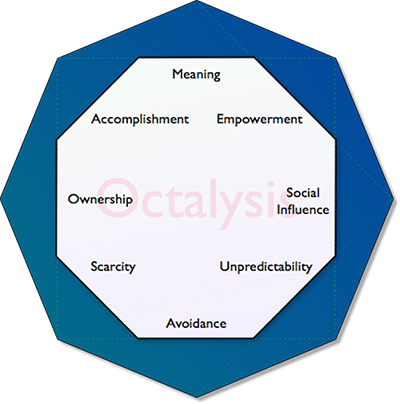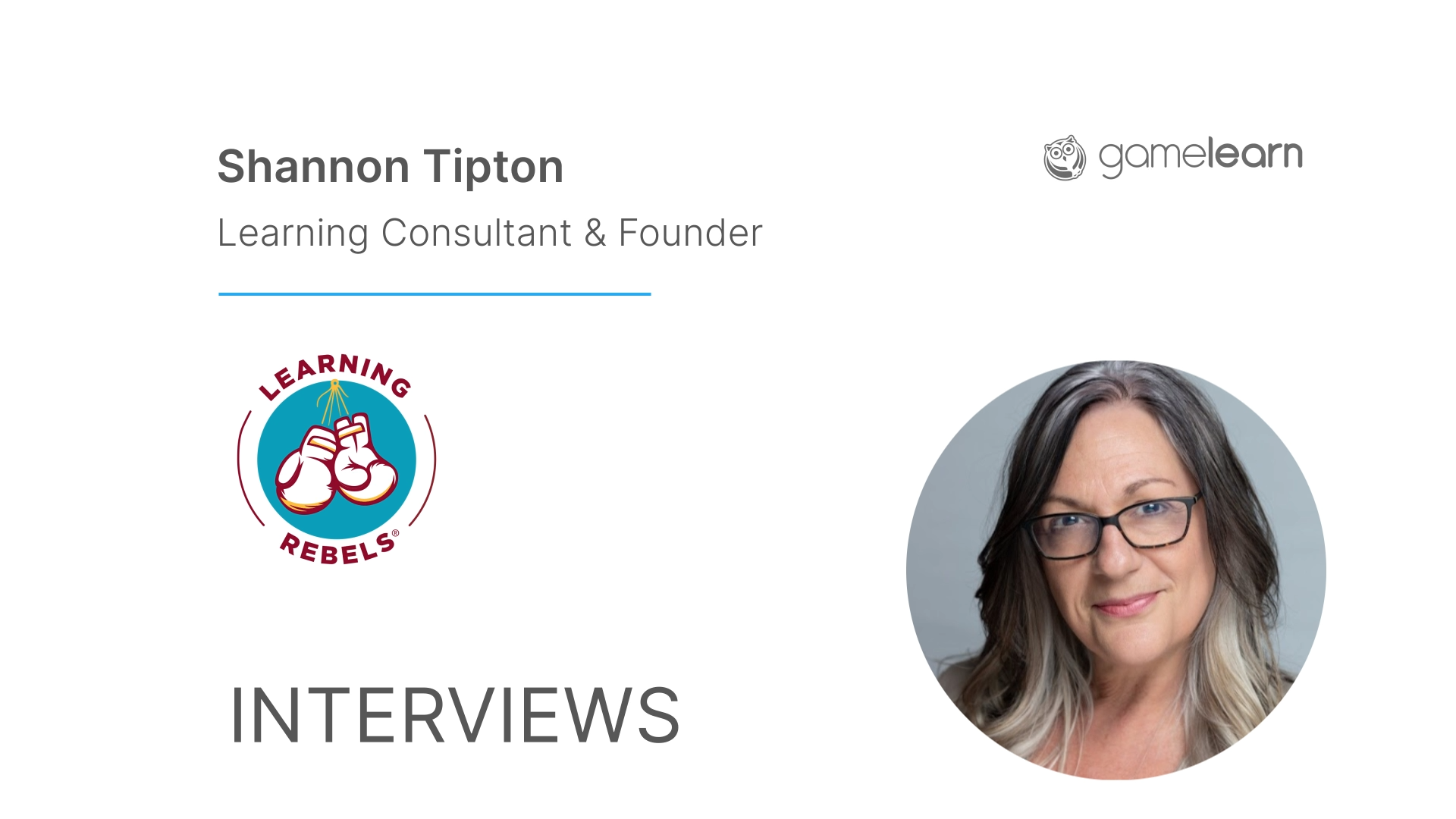Yu-kai Chou is one of the most famous names in the world in gamification. He started working in the field in 2003, when gamification wasn´t such a buzzword, and is a renowned speaker (including his TED talk), writer (Actionable Gamification) and consultant (for companies such as eBay, Huawei, Verizon, HP, Ericsson and Cisco). He champions the benefits of gamification all over the world and is one of the strongest advocates of going well beyond the simple use of points, badges and leaderboards.
At Gamelearn, we have had the opportunity to talk with Yu-kai Chou about the best examples of gamification, how to use it in learning & development and the keys to introducing game mechanics in a company.
– As gamification spreads all over the world, there is a growing debate about whether or not gamification works. Some people believe it is a game changer, while others think it is just an over-hyped fashion that will no longer be a hot topic in a few years’ time. Why do you believe gamification works?
Well, considering I have only been working on gamification for the past 10 years, and I still have a job today, I think it works pretty well [laughs].
There are two big things. First, most games in the market are not successful too. It depends on how you design them, right? Most of them are not fun to play, and if they are not fun, they fail. But you only hear about the 1% of very successful ones. It´s the same with gamification. If it is not well designed, then gamification fails.
The other thing is how you define gamification. If people say you just need leaderboards, points and badges, then I agree that gamification fails. But if gamification is designed to develop more important activities, I think there is every opportunity to be successful.
– So what do you think is the key to achieving well-designed gamification?
The key is to first of all focus on the physiological core drives as opposed to the game elements. A lot of people focus on game mechanics or game elements and they say: “hey, if you just put in some points and badges, or quests or doubling up, you will be successful”. But again: every single game has these elements, and most are failures. So it´s not realistic to think that if you take these elements, that are even found in boring games, and put them into my product then it will automatically become a successful gamification activity. It doesn´t happen that way.
The key for design gamification is whether it kicks on the right physiological drives. If there is a sense of curiosity, a sense of strategy, social influence, creativity… these things are more important. It´s like badges: people have to be proud of them. It has to represent something. Very often the game element is there, but not the core drive.
And the second factor is to understand the motivation effect the white hat core drives and the black hat core drives can have. With white hat design (things like development and accomplishment, creativity or epic meaning) people feel good about it because there is no sense of emergency, so people procrastinate and don’t finish up very quickly. But with the black hat (core drives such as scarcity, curiosity or loss and avoidance) you can feel the urgency, you can obsess or even get addicted.
So good gamification design is really about understanding the dynamics and balancing the good feeling of the white hat core drives and the sense of urgency of the black hat core drives.

– So which core drive is your favorite? Which one do you believe, generally, works better?
Every core drive has pros and cons. It´s always a trade-off. Some of them do one thing very well, but others have a weakness.
But, generally speaking, if you can use core drive 3 (empowerment of creativity and feedback), that´s the best, because that´s the right top part of the octagon. This gives people a sense of strategy, a sense of self-expression. You can look at chess, look at poker or mahjong, they all have this core drive. And it doesn´t need to add more content or mission to stay relevant; their brains are entertained. This core drive is the most rewarding to create, but it´s very difficult.
The core drive that intrigues me the most is the opposite: scarcity and impatience. This is black hat and extreme left. With every other core drive you might think: “oh yes, it´s true, I never thought about it, but now that you mention it, it makes sense”. But the scarcity core drive, when you talk about it, they won´t believe you.
One example: there is a game design technique, I call it the magnetic cap, which is that if you need to increase a certain behavior, put a limit on how many people can do it. It´s counterintuitive: if you want them to share with their friends a thousand times, why would you limit how many times they can do it? The problem is: if you say: “hey, do this a million times, then they don´t care, they do zero times”. But if you impose a limit, then suddenly they want to do it more.
For example, a startup called me once, and they said: “hey, Yu-kai, we are trying to get college students to sign petitions for good causes and we noticed that the problem is that most people just sign once. And then they get lazy. Even the more active users, the crazy ones, sign only three petitions a day. We then read about your magnetic cap technique so we tried it out and we said: “you are only allowed to sign 3 petitions a day”. And then suddenly everyone is signing 3 petitions a day. It works like magic. So scarcity is a very intriguing type of core drive. But you have to bear one thing in mind: with this core drive you can obtain immediate results, but in the long run people might burn out, unlike with white hat drives.
– In recent years there have been many good examples of gamification. Do you have your own favorite?
Yes, there are quite a few. There is one that I particularly enjoyed from South Korea and which I think is very creative and innovative. It´s a mall chain called Emart. They saw that throughout the day their traffic and revenue are very strong, but that both ease at noon, because people go to lunch. They offer lunch at Emart too, but most people don´t think this is a lunch place.
So what they did is build a very abstract-looking statue in front of every Emart location. It´s very abstract and it doesn´t look like anything. However, at noon, the position of the sun causes the shadow of the statue to become a perfect QR code that people can scan. So suddenly you have that scarcity component, right? Because this can only happen at noon on a sunny day. There is unpredictability and curiosity. It´s intriguing and exciting. It´s almost like you are in an India Jones movie. This design increased their traffic and revenue by 40% at noon. It made a big difference.
– Now there are more and more companies which are perhaps thinking about gamification and how can they integrate it into their businesses. What would you recommend that companies do as their first step into gamification?
I think the most important thing is to understand why successful games work. This is essential. If you just think: “oh, let´s just make it look like a game”. Then there’s a strong chance that you are going to fail. Because, like I said, many games that look like games fail. So, the successful games versus the failed games… what are the key differences? You have to understand this and you have to think about how to implement that key difference into your product.
In my work, I have the Octalysis Framework Analysis, which I think so far has proved a good way, and a very international verified way, to figure this out, but the key to gamification is understanding that is not about making something look like a game, but making something psychologically appealing like a successful game.
– Many companies are also trying to apply gamification to learning & development…
Absolutely. The sweet spot of gamification is everything that is extremely, extremely important; but somehow boring and mundane. This includes things like education, finance, insurance… And education and training is one of them. And it actually has a lot of power behind it, because most people recognize that learning should be fun or engaging. Financial firms are doing lots of gamification projects for training.
What people don’t like is going to a lecture, doing lots of tests and then writing it all down on a piece of paper. We like to use our creativity and we like the feeling of empowerment. Based on how you play the game and how you go through the training, there are consequences. So some players will say: “hey, let me go back and I will make other choices”. So you actually learn through trial and error, and this is how your brain gets engaged with the training.
When it comes to pure memorization, one of the examples I like to talk about is kids who play games like Magic: The Gathering. This is a card game which requires the players to memorize a lot of information. There are over a thousand cards, each with two different stats, and the kids who play this will not only memorize every single stat, they will also memorize your card counters, my card counters, his card.
Actually, there is more information in this game than in the periodic table elements. It´s like memorizing not only every single element, but its exact weight, the exact placement and how every single chemical element interacts with every other element. The difference is that when they memorize the periodic table of elements they are trying not to get in trouble with their parents, they are trying to get a good grade… and usually it doesn’t matter if you are an A student, a B student or a C student, you study hard enough to get your acceptable grade and then you stop; and you probably go and play games. Whereas when you study for the card games, every game enables you to become more powerful, to use more strategy, more creativity, to meet your friends… so as a means to an end, you have to memorize a lot of information, and that´s not only acceptable, it’s also enjoyable.
So some companies will come and tell me: “oh, I have blue collar laborers, and they don’t have the capacity to learn all these things and items”. Or they say: “oh, my sales team, they can’t learn all the insurance products”. And I tell them: “no, it’s not a problem of intelligence, it´s a problem of motivation and engagement“.
– Do you have a favorite initiative in learning and development where using gamification has been very successful? Is there an example that comes to mind?
We worked on a project called Trade Samurai, about Forex Trading. We turned learning how financial markets work into a samurai journey game.
This is for one of the biggest Forex Trading training companies in Australia, which noticed that it had two problems: the first is that Forex Trading feels intimidating, scary and abstract, and it didn’t know how to address this issue; and the second is that even if people do acquire a little knowledge and quickly start trading, they then lose a lot of money because they are not prepared. So our goal was to make learning fun and exciting, so people would jump into the experience and then design a game where the characters would balance the evil forces of greed and fear. You learn the foundation stuff, technical training… but there is a sensei and sometimes you ride a dragon, and stuff like that. So you solve the first problem by getting the player to think: “hey, let´s start this game, Forex Trading is not intimidating anymore”, while the second is addressed because the learning content is so interesting and the player learns a great deal before using real money.
https://www.tradesamurai.com/
Another gamification learning example I enjoy very much is Dragon Box. This game has managed to get little kids, from seventh to fifth grade, addicted to solving hundreds of algebra problems. I remember in eighth grade algebra was not overwhelming for me, but it was a very difficult course, very serious and very hard. It´s like cold work: math, algebra… but Dragon Box manages to get seventh graders to enjoy algebra. They don’t even think they are doing math: they think they are trying to feed the dragon. Somehow dragons are very shy, so they only want to eat when they are isolated. So you have to move the dragon to one side of the equation, like X. So as the kids figure out how to get this dragon to eat the food, they are really solving algebra questions.
– Apart from making us do boring stuff, in your TED conference you also said that gamification can help to create a better world.
You can if you do it right.
This goes back to the Octalysis Framework. So, white hat motivation is what makes us happy; and black hat motivation is what creates urgency, but from activities that don’t necessarily make us happy. So with a white hat core drive, for example, you are changing the world, you pursue your faith, you are developing and accomplishing something, you are using your creativity. It feels very good. Those are things that we want to do and which, if we end up doing them, make us happy.
Unfortunately, what we do on a day-to-day basis are the black hat things. Loss of avoidance: “oh, there is a deadline coming, I need to do this”. Scarcity: “oh, there is this exclusive offer, I have to go and take advantage of this”. Unpredictability and curiosity: “What´s on Facebook? What´s on Pinterest? What´s on Game of Thrones?”. So we spend a lot of our time everyday doing this black hat stuff which doesn’t make us happy. Unfortunately, most companies, our environment and our surroundings, are constantly sending us black hat motivations and therefore preventing us from doing white hat things.
This is a little bit like things that are important and things that are urgent. We usually do the urgent non-important things. We have to do the important things, but usually we spend time on urgent and non-important things. But if we spend our time on important and non-urgent things, we are happier. This can make us stronger in the long term and confident about ourselves.
– Gamification is becoming present in almost everything in our lives. Is there going to be a moment when every aspect of our lives is gamified?
I think everything can be more engaging and more enjoyable. But not everything needs to look like a game, to be game-played. But everything important and meaningful should also be enjoyable and engaging. So you don´t need discipline to do it, you actually need discipline to stop doing it. The idea is that you naturally want to do the meaningful things in your life. And when you are not doing them, you are constantly thinking about them.












